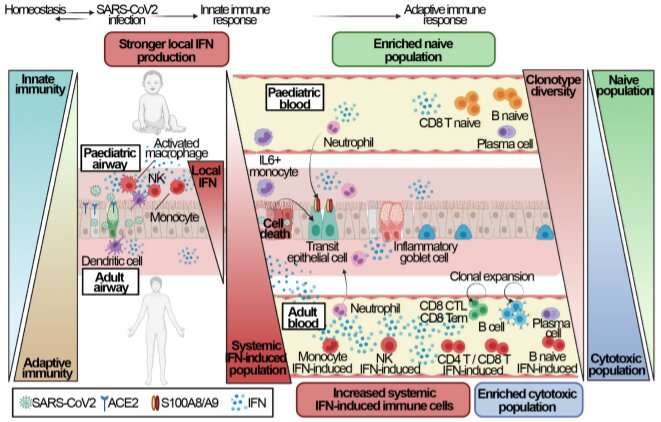Rapid immune response in children protects them from COVID-19, genetic study finds


Fundamental differences in the immune response of adults and children can help to explain why children are much less likely to become seriously ill from SARS-CoV-2, according to new research from the Wellcome Sanger Institute, University College London and their collaborators.
The study, published in Nature, is the most comprehensive single-cell study to compare SARS-CoV-2 infection in adults and children across multiple organs. Researchers found that a stronger ‘innate’ immune response in the airways of children, characterized by the rapid deployment of interferons, helped to restrict viral replication early on. In adults, a less rapid immune response meant the virus was better able to invade other parts of the body where the infection was harder to control.
As part of the Human Cell Atlas initiative to map every cell type in the human body, the findings will be a valuable contribution to predict personal risk from SARS-CoV-2. A nasal swab to measure the immune response in newly infected adults could be used to identify those at higher risk who may be candidates for pre-emptive monoclonal antibody treatment. Recent research has also suggested inhalation of interferons could be a viable therapy.
The immune system that we are born with is not the same as the one we have as adults. The ‘innate’ immune system of children is better able to recognize dangerous viruses or bacteria automatically, triggering ‘naïve’ B and T cells that can adapt to the threat. Adults have a more ‘adaptive’ immune system containing a huge repertoire of ‘memory’ B and T cell types, which have been trained through past exposure to respond to a particular threat. Though the adult immune system also has an innate response, it is more active in children.
One of the key mechanisms of both immune systems is a group of proteins called interferons, which are released in the presence of viral or bacterial threats and tell nearby cells to tighten their defenses. Interferons are proteins with strong anti-viral activity and their production will typically lead to the activation of B and T cells, which kill infected cells and prevent the pathogen from spreading further.
For this study, researchers at University College London (UCL) and affiliated hospitals, collected and processed matched airway and blood samples from 19 pediatric and 18 adult COVID-19 patients with symptoms ranging from asymptomatic to severe, as well as control samples from 41 healthy children and adults.
Single-cell sequencing of the samples was done at the Wellcome Sanger Institute to generate a dataset of 659,217 individual cells. These cells were then analyzed, revealing 59 different cell types in airways and 34 cell types in blood, including some never previously described.
Analysis showed that interferons were more strongly expressed in healthy children compared to adults, with a more rapid immune response to infection in children’s airways. This would help to restrict viral replication early on and give children an immediate advantage in preventing the virus from infecting the blood and other organs.
“Because SARS-CoV-2 is a new virus, it isn’t something that the adaptive immune system of adults has learned to respond to. The innate immune system of children is more flexible and better able to respond to new threats. What we see at a molecular level are high levels of interferons and a very quick immune response in children that helps to explain why they are less severely affected by COVID-19 than adults,” says Dr. Masahiro Yoshida, University College London.
The study also detailed how the immune system of adults, with its high numbers of ‘killer’ immune cells such as B and T cells, can work against the body once SARS-CoV-2 has spread to other parts of a patient.
“Compared to children, adult blood has a greater number and variety of cytotoxic immune cells, which are designed to kill infected cells to prevent an infection spreading. But it is a fine line between helping and hindering. Once the virus has spread to several areas of the body, organ damage can be caused by the immune system trying and failing to control the infection. Our study shows that not only do children respond better initially, if the virus does enter the blood the cytotoxic response is less forceful,” says Dr. Marko Nikolić, University College London.
Knowing exactly how and why the immune response to SARS-CoV-2 can fail to control the infection or start to harm the body provides scientists with the means to start asking why certain individuals may be at greater risk of serious illness.
These data suggest that newly diagnosed adults could be tested to check interferon levels in the airway. Higher interferon levels, similar to those found in children, would suggest a lower risk of severe disease, whereas low interferon levels would suggest higher risk. Higher risk patients could then be considered for pre-emptive treatments such as monoclonal antibodies, which are expensive and can be in limited supply.
“To put it simply, the innate immune response is better at fighting COVID-19 and children have stronger innate immunity, but immunity is also a complex ballet involving many types of cells. The timing and the types of cells that are triggered will influence how an infection develops, and this will vary between individuals for all sorts of reasons in addition to age. Some of the differences we observe between children and adults may help us to think about how we gauge personal risk for adults as a way of mitigating serious illness and death,” says Dr. Kerstin Meyer, Wellcome Sanger Institute.
In addition, there is growing evidence of the therapeutic benefits of inhaled interferon beta 1a. Based on the study results, this should be particularly the case for patients with weak or absent interferon activation.
Source: Read Full Article